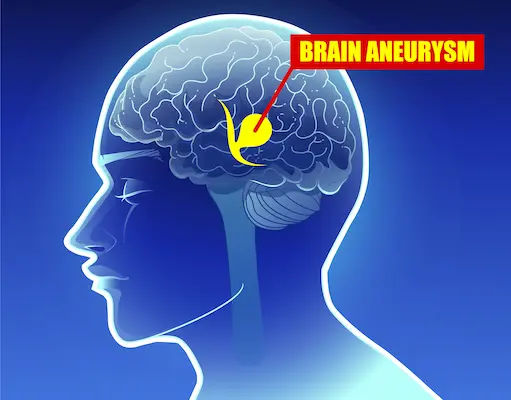Guide to Frequently Asked Questions Brain Aneurysms
Explore brain aneurysms in depth with causes, symptoms, risk factors, diagnosis, treatment options, and recovery. Learn how to recognise warning signs and when to seek urgent care.

Written by Dr. M L Ezhilarasan
Reviewed by Dr. Rohinipriyanka Pondugula MBBS
Last updated on 18th Sep, 2025
.webp?tr=q-80,f-webp,w-350,dpr-2,c-at_max 700w)
Introduction
The term "brain aneurysm" often strikes fear, conjuring images of a sudden, catastrophic health event. But knowledge is power. A brain aneurysm is a weak, bulging spot on the wall of a brain artery, much like a thin, overinflated balloon. The real danger lies in its potential to rupture, causing a life-threatening bleed into the brain. However, it's crucial to know that many aneurysms never rupture and may only require careful monitoring. This comprehensive guide demystifies brain aneurysms, breaking down the causes, silent symptoms, key risk factors, and advanced treatment options. Whether you're seeking information for yourself or a loved one, our goal is to provide clear, actionable knowledge to help you navigate this complex condition and understand when to seek expert medical advice.
What Exactly is a Brain Aneurysm?
A brain aneurysm, medically known as a cerebral or intracranial aneurysm, is not a tumor or a mass of abnormal cells. It is a structural problem with a blood vessel. Imagine the arteries in your brain as sturdy garden hoses carrying vital blood. Over time, pressure from blood flow can create a weak spot in the hose wall. This weak spot can then bulge outward, forming a sac filled with blood. This sac is the aneurysm.
Most brain aneurysms are small—often less than ¼ inch wide—and may go through life completely unnoticed, causing no symptoms. They are often described as "berry" aneurysms due to their shape. The primary concern is that the wall of this sac is thinner and weaker than the artery wall. If the pressure inside becomes too great, it can rupture, spilling blood into the space around the brain (a subarachnoid hemorrhage), which is a medical emergency.
The Balloon Analogy: Understanding the Weak Spot
The balloon analogy is the simplest way to understand it. A new, high-quality balloon is like a healthy artery. If you blow into it, it expands evenly. But if there's a tiny, weak, overstretched spot on the balloon, that spot will bulge out first when you blow air into it. That bulge is the aneurysm. The more you blow (increased blood pressure), the larger and thinner the weak spot becomes, increasing the risk of it popping.
Consult Top Specialists
Who is at Risk? Key Brain Aneurysm Risk Factors
Understanding the risk factors is a critical step in awareness. They are generally divided into factors you can't change and those you can influence.
Uncontrollable Risk Factors
- Genetics and Family History: Having a first-degree relative (parent, sibling, or child) who has had a brain aneurysm significantly increases your risk. Certain inherited connective tissue disorders, like Ehlers-Danlos syndrome, also elevate risk.
- Age: The risk increases with age, peaking in adults between 40 and 60 years old.
- Gender: Women are more likely to develop a brain aneurysm or suffer a rupture than men, potentially due to hormonal factors and the loss of protective estrogen after menopause.
- Pre-existing Conditions: People with polycystic kidney disease, arteriovenous malformations (AVMs), or a history of serious head trauma are at higher risk.
Lifestyle and Controllable Risk Factors
- High Blood Pressure (Hypertension): This is a major controllable risk factor. The constant force of high-pressure blood flow can damage and weaken artery walls.
- Smoking: This is arguably the most significant and modifiable risk factor. It not only increases blood pressure but also damages and weakens the walls of blood vessels directly.
- Excessive Alcohol Consumption: Particularly binge drinking, which can cause a sudden spike in blood pressure.
If you have multiple risk factors, especially a family history, it's wise to discuss your concerns with a doctor. They can assess your overall risk and recommend lifestyle changes. If you need help managing high blood pressure, consult a doctor online with Apollo24|7 for a personalized plan.
The Silent Threat: Recognizing Brain Aneurysm Symptoms
This is perhaps the most critical section, as symptoms vary drastically between an unruptured and a ruptured aneurysm.
Symptoms of an Unruptured Aneurysm
Most unruptured aneurysms are silent. However, if they grow large enough, they can press on nerves or brain tissue, causing warning signs. These unruptured brain aneurysm symptoms can include:
- Pain above or behind one eye.
- A dilated pupil in one eye.
- Vision changes (double vision, blurriness).
- Numbness or weakness on one side of the face.
- Drooping eyelid (ptosis).
The "Thunderclap" Headache: Symptoms of a Rupture
A ruptured brain aneurysm is a life-threatening event. The key symptom is an excruciatingly sudden and severe headache, often described as the "worst headache of my life" or a "thunderclap headache." It hits its peak intensity within seconds. Other symptoms of a rupture include:
- Nausea and violent vomiting.
- Stiff neck.
- Sensitivity to light (photophobia).
- Seizure.
- Loss of consciousness or sudden confusion.
- Drooping eyelids.
What to Do in a Suspected Rupture: Act F.A.S.T.
A ruptured aneurysm is a stroke—a hemorrhagic stroke. Every second counts. Call for emergency medical help immediately (e.g., 108 or your local emergency number). Do not drive yourself to the hospital.
How are Brain Aneurysms Diagnosed?
Diagnosis often begins after symptoms appear or if an aneurysm is discovered incidentally during a scan for another condition. Diagnosis relies on imaging tests that provide detailed pictures of the brain's blood vessels.
Imaging Tests: CT, MRI, and Angiography
- CT (Computed Tomography) Scan: This is usually the first test done in the emergency room for a suspected rupture. It can quickly detect bleeding in the brain.
- CT Angiography (CTA) or MR Angiography (MRA): These are non-invasive tests that involve injecting a contrast dye into a vein and then using CT or MRI technology to create detailed 3D images of the blood vessels in the brain, highlighting the size and shape of an aneurysm.
- Cerebral Angiogram (DSA): This is the gold standard for diagnosis. It's a more invasive procedure where a catheter is threaded from the groin up to the brain's arteries, and dye is injected. It provides the most detailed view of the aneurysm's structure and blood flow, crucial for planning brain aneurysm treatment options.
Brain Aneurysm Treatment Options: To Treat or to Monitor?
The decision depends on the aneurysm's size, location, shape, the patient's age and overall health, and family history.
Monitoring (Watchful Waiting)
For small, unruptured aneurysms with a low risk of rupture, the best course may be monitoring. This involves regular imaging (e.g., MRA every 6-12 months) to check for growth, alongside controlling risk factors like blood pressure and quitting smoking.
Surgical Clipping: The Traditional Approach
This is an open-brain surgery performed by a neurosurgeon. The surgeon places a tiny metal clip across the "neck" of the aneurysm, stopping blood flow into it. The clip remains in place permanently. It's a highly effective but invasive procedure.
Endovascular Coiling: A Less Invasive Procedure
This is a less invasive alternative to clipping. A neurosurgeon or interventional neuroradiologist threads a catheter through an artery in the groin up to the aneurysm. Through the catheter, they place soft platinum coils into the aneurysm sac. The coils promote blood clotting, sealing off the aneurysm from the inside. Endovascular coiling typically has a shorter recovery time than surgical clipping.
Flow Diverters and Newer Techniques
For complex aneurysms, newer devices like flow diverters (stent-like tubes) can be placed in the main artery to redirect blood flow away from the aneurysm, allowing it to clot and shrink over time.
Life After a Brain Aneurysm: Recovery and Rehabilitation
Brain aneurysm surgery recovery time varies widely. Recovery from a coiling procedure may take weeks, while recovery from a clipping procedure and especially from a rupture can take months to years. Rehabilitation after a rupture is often necessary and may involve physical, occupational, and speech therapy to address deficits caused by the brain bleed. Emotional support and counseling are also vital components of recovery.
Can You Prevent a Brain Aneurysm?
You can't always prevent one, especially if genetics are a factor, but you can drastically reduce your risk by managing the controllable factors:
- Don't smoke. If you do, seek help to quit.
- Control your blood pressure through diet, exercise, and medication if prescribed.
- Eat a heart-healthy diet low in sodium and saturated fat.
- Exercise regularly.
- Limit alcohol consumption.
- Managing these factors is the best proactive step you can take for your brain's vascular health.
Quick Takeaways: Key Points to Remember
- A brain aneurysm is a bulge in a weak spot of a brain artery, not a tumor.
- Many aneurysms are silent and never rupture.
- A sudden, severe "thunderclap" headache is the hallmark sign of a rupture—seek emergency help immediately.
- Smoking and high blood pressure are the two biggest controllable risk factors.
- Treatment isn't always necessary; monitoring is often an option for small, low-risk aneurysms.
- Modern treatments like endovascular coiling offer less invasive options with faster recovery.
- Recovery is possible, and rehabilitation plays a crucial role after a rupture.
Consult Top Specialists
Conclusion
Understanding brain aneurysms is the first step in mitigating fear and taking proactive control of your health. While the thought of a rupture is frightening, it's important to remember that many people live with unruptured aneurysms without ever knowing. The power of prevention lies largely in lifestyle choices: managing blood pressure, avoiding tobacco, and maintaining a healthy heart. If you have a strong family history or concerning symptoms, do not hesitate to seek medical guidance. Early detection and expert consultation are paramount. If you have risk factors and are experiencing persistent headaches or other neurological symptoms, consulting a neurologist online with Apollo24|7 can provide a crucial first step towards evaluation and peace of mind. Stay informed, stay proactive, and always prioritize your neurological health.
Consult Top Specialists

Dr. Rajib Ghose
General Physician/ Internal Medicine Specialist
25 Years • MBBS
East Midnapore
VIVEKANANDA SEBA SADAN, East Midnapore

Dr. Aritra Kumar Ray
General Physician/ Internal Medicine Specialist
10 Years • MBBS, MD (General Medicine)
East Midnapore
VIVEKANANDA SEBA SADAN, East Midnapore

Dr. Sougata Kumar
General Practitioner
8 Years • MBBS
East Midnapore
VIVEKANANDA SEBA SADAN, East Midnapore

Dr. Abhishek Ranjan
General Practitioner
4 Years • MBBS
Kolkata
VDC Clinic, Kolkata

Dr. Tapabrata Ray
General Physician/ Internal Medicine Specialist
4 Years • MBBS,DGM,CPMeC,ACMDC
Kolkata
MCR SUPER SPECIALITY POLY CLINIC & PATHOLOGY, Kolkata
Consult Top Specialists

Dr. Rajib Ghose
General Physician/ Internal Medicine Specialist
25 Years • MBBS
East Midnapore
VIVEKANANDA SEBA SADAN, East Midnapore

Dr. Aritra Kumar Ray
General Physician/ Internal Medicine Specialist
10 Years • MBBS, MD (General Medicine)
East Midnapore
VIVEKANANDA SEBA SADAN, East Midnapore

Dr. Sougata Kumar
General Practitioner
8 Years • MBBS
East Midnapore
VIVEKANANDA SEBA SADAN, East Midnapore

Dr. Abhishek Ranjan
General Practitioner
4 Years • MBBS
Kolkata
VDC Clinic, Kolkata

Dr. Tapabrata Ray
General Physician/ Internal Medicine Specialist
4 Years • MBBS,DGM,CPMeC,ACMDC
Kolkata
MCR SUPER SPECIALITY POLY CLINIC & PATHOLOGY, Kolkata
More articles from Brain Aneurysm
Frequently Asked Questions
How common are brain aneurysms?
It's estimated that 1 in 50 people may have an unruptured brain aneurysm, but the vast majority will never know and it will never cause problems. Ruptures are far less common, occurring in about 10 out of every 100,000 people annually.
Can stress cause a brain aneurysm to rupture?
While sudden, extreme stress can cause a temporary spike in blood pressure, there is no direct evidence that everyday stress causes a rupture. The chronic high blood pressure from unmanaged stress is a more significant long-term risk factor than a single stressful event.
What is the brain aneurysm survival rate after a rupture?
Unfortunately, a rupture is very serious. About 40% of ruptures are fatal within the first 24 hours. Of those who survive, around 66% will experience some permanent neurological deficit. This highlights the critical importance of emergency treatment.
Are there warning signs days before an aneurysm ruptures?
In some cases, a 'sentinel headache' or warning leak may occur days or weeks before a major rupture. This is a sudden, severe headache that is different from past headaches but may resolve. It is caused by a tiny leak of blood. Any sudden, unusual headache warrants medical attention.
Can you live a normal life with an unruptured aneurysm?
Absolutely. Many people do. With a management plan from your doctor—which may include regular monitoring and lifestyle modifications—you can live a full, active life. The decision to treat is made on a case-by-case basis after weighing the risks of treatment against the risk of rupture.

